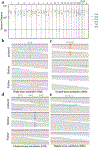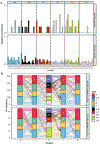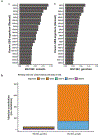SNV/indel hypermutator phenotype in biallelic RAD51C variant: Fanconi anemia
- PMID: 37031326
- PMCID: PMC10996436
- DOI: 10.1007/s00439-023-02550-4
SNV/indel hypermutator phenotype in biallelic RAD51C variant: Fanconi anemia
Abstract
We previously reported a fetus with Fanconi anemia (FA), complementation group O due to compound heterozygous variants involving RAD51C. Interestingly, the trio exome sequencing analysis also detected eight apparent de novo mosaic variants with variant allele fraction (VAF) ranging between 11.5 and 37%. Here, using whole genome sequencing and a 'home-brew' variant filtering pipeline and DeepMosaic module, we investigated the number and signature of de novo heterozygous and mosaic variants and the hypothesis of a rare phenomenon of hypermutation. Eight-hundred-thirty apparent de novo SNVs and 21 de novo indels had VAFs below 37.41% and were considered postzygotic somatic mosaic variants. The VAFs showed a bimodal distribution, with one component having an average VAF of 25% (range: 18.7-37.41%) (n = 446), representing potential postzygotic first mitotic events, and the other component with an average VAF of 12.5% (range 9.55-18.69%) (n = 384), describing potential second mitotic events. No increased rate of CNV formation was observed. The mutational pattern analysis for somatic single base substitution showed SBS40, SBS5, and SBS3 as the top recognized signatures. SBS3 is a known signature associated with homologous recombination-based DNA damage repair error. Our data demonstrate that biallelic RAD51C variants show evidence for defective genomic DNA damage repair and thereby result in a hypermutator phenotype with the accumulation of postzygotic de novo mutations, at least in the prenatal period. This 'genome hypermutator phenomenon' might contribute to the observed hematological manifestations and the predisposition to tumors in patients with FA. We propose that other FA groups should be investigated for genome-wide de novo variants.
© 2023. The Author(s), under exclusive licence to Springer-Verlag GmbH Germany, part of Springer Nature.
Conflict of interest statement
Statements and Declarations
Competing interests
JRL has stock ownership in 23andMe, is a paid consultant for Genomics International, and is a coinventor on multiple United States and European patents related to molecular diagnostics for inherited neuropathies, eye diseases, genomic disorders, and bacterial genomic fingerprinting. The Department of Molecular and Human Genetics at Baylor College of Medicine receives revenue from clinical genetic testing conducted at Baylor Genetics Laboratories.
Figures




Update of
-
SNV/indel hypermutator phenotype in biallelic RAD51C variant - Fanconi anemia.Res Sq [Preprint]. 2023 Mar 2:rs.3.rs-2628288. doi: 10.21203/rs.3.rs-2628288/v1. Res Sq. 2023. Update in: Hum Genet. 2023 Jun;142(6):721-733. doi: 10.1007/s00439-023-02550-4. PMID: 36909564 Free PMC article. Updated. Preprint.
References
-
- Alexandrov LB, Kim J, Haradhvala NJ, Huang MN, Tian Ng AW, Wu Y, Boot A, Covington KR, Gordenin DA, Bergstrom EN, Islam SMA, Lopez-Bigas N, Klimczak LJ, McPherson JR, Morganella S, Sabarinathan R, Wheeler DA, Mustonen V, Group PMSW, Getz G, Rozen SG, Stratton MR, Consortium P (2020) The repertoire of mutational signatures in human cancer. Nature 578: 94–101. doi: 10.1038/s41586-020-1943-3 - DOI - PMC - PubMed
-
- Ameziane N, May P, Haitjema A, van de Vrugt HJ, van Rossum-Fikkert SE, Ristic D, Williams GJ, Balk J, Rockx D, Li H, Rooimans MA, Oostra AB, Velleuer E, Dietrich R, Bleijerveld OB, Maarten Altelaar AF, Meijers-Heijboer H, Joenje H, Glusman G, Roach J, Hood L, Galas D, Wyman C, Balling R, den Dunnen J, de Winter JP, Kanaar R, Gelinas R, Dorsman JC (2015) A novel Fanconi anaemia subtype associated with a dominant-negative mutation in RAD51. Nat Commun 6: 8829. doi: 10.1038/ncomms9829 - DOI - PMC - PubMed
MeSH terms
Substances
Grants and funding
LinkOut - more resources
Full Text Sources
Research Materials
Miscellaneous

